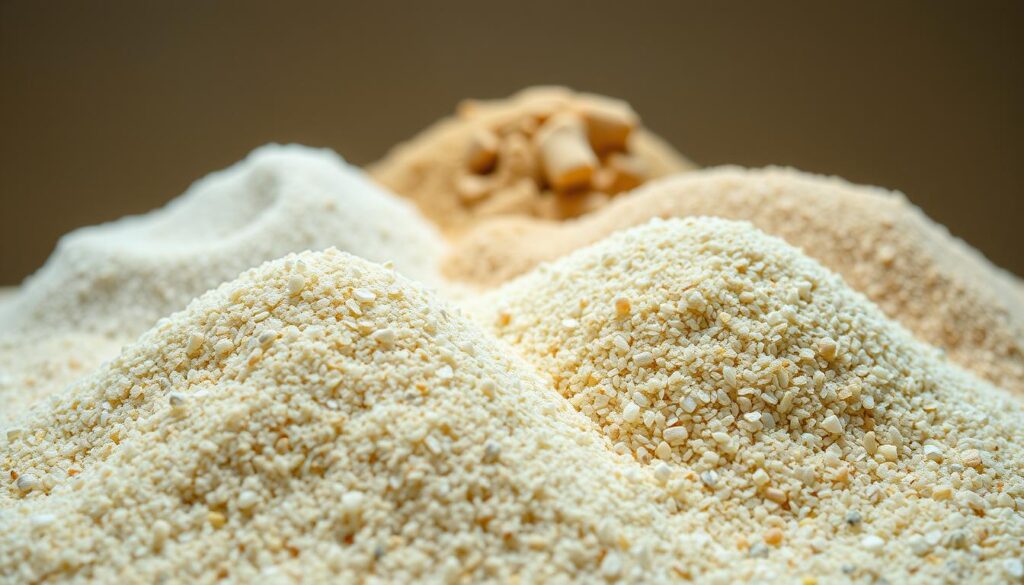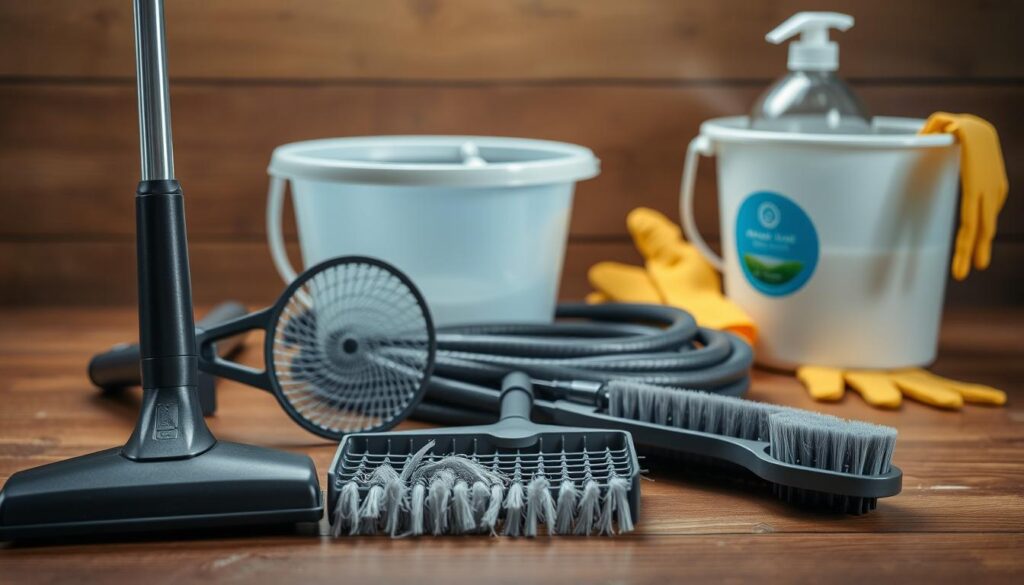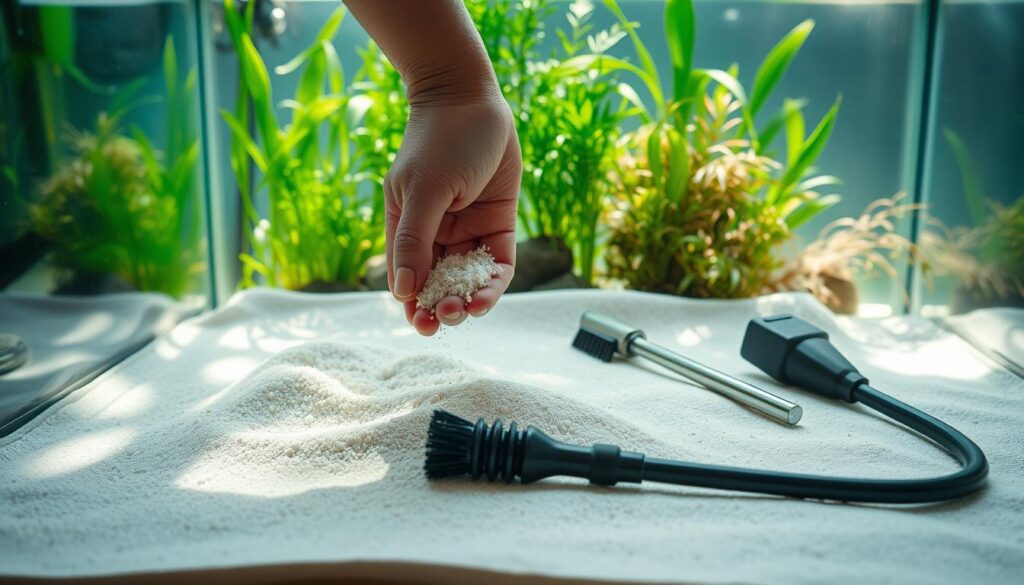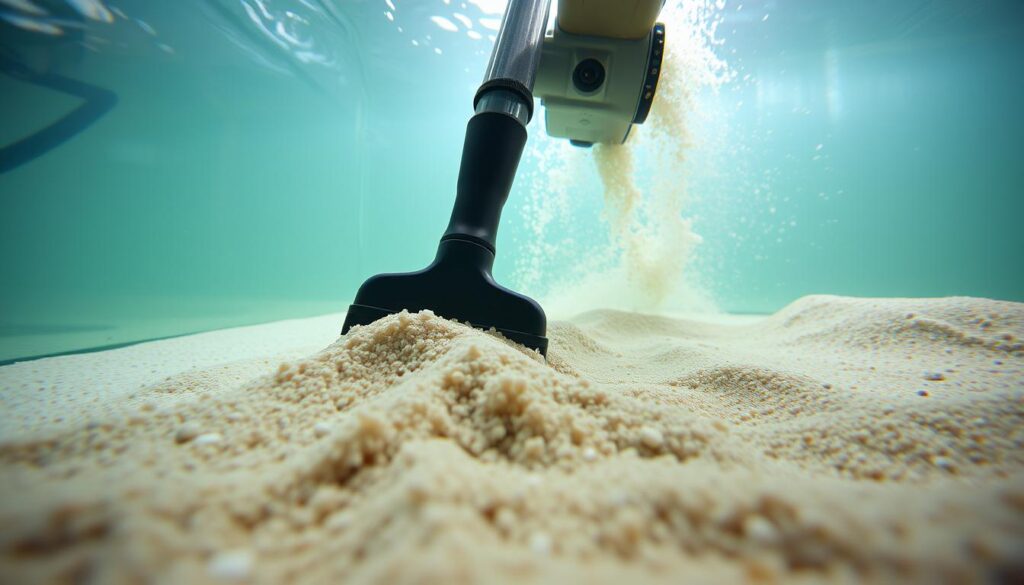Keeping your tank clean is key to a healthy aquatic environment, and knowing how to clean aquarium sand plays a big part in that. Unlike gravel, sand can trap waste and debris more easily, making regular maintenance essential. But don’t worry—it’s not as difficult as it sounds! With the right techniques, you can clean your aquarium sand quickly and effectively without disturbing your fish or plants. In this guide, we’ll walk you through simple methods to keep your sand spotless and your tank thriving.
Dirty sand can lead to a range of problems, from cloudy water to stressed fish. That’s why regular aquarium sand cleaning is crucial! By keeping your sand clean, you’ll be creating a healthier environment for your aquatic friends to thrive.
So, are you ready to give your tank the TLC it deserves? In this article, we’ll share our top tips on how to keep your aquarium sand sparkling clean, ensuring your tank remains a happy and healthy haven for your fish!
Key Takeaways
- Regular aquarium sand cleaning is essential for a healthy aquatic ecosystem.
- Dirty sand can lead to cloudy water and stressed fish.
- Cleaning your sand regularly will help keep your tank looking its best.
- A well-maintained tank is a happy tank!
- Simple maintenance can make a big difference in your aquarium’s health.
The Importance of Clean Aquarium Sand
A clean substrate is more than just a pretty face; it’s essential for the well-being of your fish and plants! When you think about aquarium maintenance, you might focus on water changes and filter cleaning, but the state of your sand is just as crucial. Let’s dive into why keeping your aquarium sand clean is so important!
How Dirty Sand Affects Water Quality
Dirty sand can lead to the accumulation of harmful bacteria and toxins, which can cause various health problems for fish, snails, and other aquatic creatures. As debris breaks down, it releases ammonia and nitrite, polluting the water and stressing your aquatic life. Regular cleaning of your aquarium sand is vital to prevent these issues and keep your water parameters in check.
Impact on Fish Health and Plant Growth
The health of your fish and plants is directly linked to the condition of your substrate. Dirty sand can harbor harmful pathogens that can infect your fish, while clean sand promotes healthy root growth for your plants. By maintaining clean sand, you’re creating a healthier environment for both your fish and plants to thrive.
Aesthetic Benefits of Well-Maintained Substrate
Let’s not forget the visual appeal! Clean aquarium sand makes your tank look more vibrant and inviting. A well-maintained substrate can make all the difference in showcasing your fish and decorations. As the saying goes, “A clean tank is a happy tank!”
By understanding the importance of clean aquarium sand, you’ll be motivated to keep your tank in top condition. Remember, regular sand cleaning is a key part of aquarium sand maintenance and will help you enjoy a thriving aquatic environment.
Understanding Different Types of Aquarium Sand
The world of aquarium sand is diverse, offering a range of options that cater to different tank setups and aquatic needs. As an aquarium enthusiast, you’re likely aware that the type of sand you choose can significantly impact the health and appearance of your tank.
Let’s dive into the different types of aquarium sand and explore their unique properties.
Fine vs. Coarse Sand Properties
Fine sand has smaller particles, typically ranging from 0.05 to 0.5 mm in diameter. It’s ideal for planted tanks, as it allows for healthy root growth. However, it can be more prone to compacting, which may lead to anaerobic pockets. On the other hand, coarse sand has larger particles, usually between 0.5 to 2 mm in diameter. It’s better for tanks with burrowing animals, as it allows for easier digging.

Colored vs. Natural Sand Considerations
Colored sand can add a vibrant touch to your aquarium, but it’s essential to choose a high-quality, non-toxic option to avoid harming your aquatic life. Natural sand, on the other hand, provides a more authentic look and can help create a balanced ecosystem. When deciding between colored and natural sand, consider the overall aesthetic you want to achieve and the needs of your tank’s inhabitants.
Special Substrate Types and Their Maintenance Needs
Some aquariums require specialized substrates to thrive. Let’s take a closer look at a few examples:
Plant-Specific Substrates
These substrates are designed to support plant growth, often containing nutrients that promote healthy root development. They’re ideal for planted tanks, where the right substrate can make all the difference.
Coral Sand for Marine Tanks
Coral sand is a popular choice for marine tanks, as it helps maintain the water’s pH and provides a natural environment for marine life. However, it requires regular maintenance to prevent compaction and ensure optimal water circulation.
| Substrate Type | Key Features | Maintenance Needs |
|---|---|---|
| Fine Sand | Small particles, ideal for planted tanks | Regular stirring to prevent compaction |
| Coarse Sand | Large particles, suitable for burrowing animals | Occasional vacuuming to remove debris |
| Coral Sand | Helps maintain pH, natural environment for marine life | Regular water changes, monitoring for compaction |
By understanding the different types of aquarium sand and their unique properties, you can make an informed decision when choosing the best sand for your tank. Remember, the right substrate can make all the difference in maintaining a healthy and thriving aquatic environment.
Essential Tools for Effective Sand Cleaning
Let’s dive into the must-have tools for keeping your aquarium sand clean and your tank thriving! Cleaning your aquarium sand is not just about aesthetics; it’s crucial for the health of your fish and plants.
Gravel Vacuums and Siphons
Gravel vacuums and siphons are the backbone of any aquarium sand cleaning routine. They help remove debris and waste from the sand, improving water quality and reducing the risk of algae blooms.
Standard vs. Battery-Powered Options
Standard gravel vacuums are manual and cost-effective, while battery-powered options offer more convenience and ease of use, especially for larger tanks or for those who prefer a more automated cleaning process.
Size Considerations for Different Tanks
The size of your gravel vacuum or siphon should be appropriate for your tank size. Larger tanks require more powerful equipment to effectively clean the sand.
| Tool Type | Tank Size | Advantages |
|---|---|---|
| Standard Gravel Vacuum | Small to Medium | Cost-effective, Easy to Use |
| Battery-Powered Vacuum | Medium to Large | Convenient, Powerful |
Specialized Sand Cleaning Tools
Beyond gravel vacuums, there are specialized tools designed to make sand cleaning easier and more efficient.
Sand Flatteners and Rakes
Sand flatteners help maintain an even substrate, while rakes are useful for gently stirring the sand to release trapped debris.
Spot Cleaning Tools
Spot cleaning tools are perfect for targeting specific areas of the sand without disturbing the rest of the substrate.

DIY Cleaning Tool Options
For the crafty aquarium enthusiast, DIY cleaning tools can be a fun and cost-effective alternative. Simple items like turkey basters or flexible tubes can be repurposed for sand cleaning.
By equipping yourself with the right tools, you’ll be well on your way to maintaining a clean and healthy aquarium. Whether you opt for commercial products or DIY solutions, the key is to find what works best for you and your tank!
Preparing Your Tank for Sand Cleaning
Before you start cleaning your aquarium sand, it’s crucial to prepare your tank properly to ensure a smooth and safe process!
Pre-Cleaning Checklist
To get started, you’ll need to follow a simple pre-cleaning checklist. First, turn off all electrical appliances to avoid any accidents or electrical shocks. Next, remove any plants and decorations that could get in the way of cleaning or get damaged during the process. Finally, prepare a large bucket to hold the water you’ll be removing from the tank.
| Task | Purpose |
|---|---|
| Turn off electrical appliances | Safety first: prevents electrical shocks |
| Remove plants and decorations | Gives you clear access to the sand and prevents damage |
| Prepare a large bucket | For holding the water removed from the tank |
Protecting Fish and Plants During Cleaning
When cleaning your aquarium sand, it’s essential to protect your fish and plants from stress and potential harm. Consider temporarily relocating your fish to a separate container filled with tank water to keep them safe. For plants, you can either wrap them gently in a soft net or remove them temporarily, just like you did with decorations.

Water Preparation for Replacement
After you’ve cleaned the sand, you’ll need to replace some of the tank water. It’s a good practice to prepare the replacement water in advance by using a water conditioner to remove chlorine and chloramines, and by matching the temperature of the new water to that of the tank. This helps minimize stress on your fish and other aquatic life.
By following these steps, you’ll be well-prepared to clean your aquarium sand effectively, ensuring a healthy environment for your fish and plants. Happy cleaning!
How to Clean Aquarium Sand: Step-by-Step Guide
Are you tired of cloudy water and dirty sand in your aquarium? Let’s dive into a step-by-step guide on how to clean aquarium sand effectively. Cleaning your aquarium sand regularly is crucial for maintaining good water quality and the overall health of your aquatic life.
Setting Up Your Equipment
Before you start cleaning your aquarium sand, make sure you have the right equipment. You’ll need a gravel vacuum or siphon hose, a bucket, and some patience! Choose a gravel vacuum that is appropriate for the size of your tank and the type of sand you have.

The Proper Vacuuming Technique
The key to cleaning aquarium sand is using the right vacuuming technique. You want to remove debris and waste without stirring up too much sediment.
Read Also Best Substrate for Planted Aquarium: What Works and What to Avoid
Hovering vs. Deep Cleaning Methods
There are two main methods: hovering just above the sand surface or inserting the vacuum deep into the sand. For most tanks, a combination of both methods works best. Start by hovering just above the surface to remove floating debris, then gently insert the vacuum into the sand to remove embedded waste.
Managing Water Flow and Suction
Be mindful of the water flow and suction power to avoid disturbing your fish or plants. Adjust the suction as needed to prevent strong currents that might cause stress to your aquatic life.
Dealing with Stubborn Debris and Waste
Sometimes, you might encounter stubborn debris or waste that’s hard to remove. Use a gentle stirring motion with your gravel vacuum to loosen these particles, then suction them out. For particularly tough cases, you might need to remove the debris manually with a soft-bristled brush or a specialized tool.
Replacing Water After Cleaning
After cleaning your aquarium sand, it’s essential to replace some of the water you’ve siphoned out. Use a water conditioner to remove chlorine and chloramines from the new water, and match the temperature and pH to your tank’s conditions. This helps maintain a stable environment for your fish and plants.
By following these steps and tips, you’ll be able to keep your aquarium sand clean and your tank looking its best. Regular maintenance is key to a healthy and thriving aquatic ecosystem!
Advanced Sand Cleaning Techniques for Different Tank Types
Different aquarium tanks require unique sand cleaning approaches to keep your underwater world thriving. Whether you’re a seasoned aquarist or just starting out, understanding the specific needs of your tank is crucial for maintaining a healthy environment.
Freshwater Tank Sand Cleaning
Freshwater tanks, especially those with community fish or specific species, require tailored cleaning techniques. When cleaning sand in a freshwater tank, it’s essential to be gentle to avoid disturbing the beneficial bacteria that help keep your tank’s ecosystem balanced.
Community Tank Considerations
For community tanks, you’ll need to be extra cautious during sand cleaning to avoid stressing the fish. Use a gravel vacuum or siphon carefully, and consider turning off powerheads temporarily to prevent stirring up debris.
Species-Specific Requirements
Some species, like catfish or loaches, are sensitive to sand disturbances. For tanks housing these species, it’s best to clean the sand during their least active periods and use gentle cleaning tools to minimize disruption.
Saltwater and Reef Tank Sand Maintenance
Saltwater and reef tanks present unique challenges when it comes to sand cleaning. The delicate balance of these ecosystems means you need to be particularly careful not to disrupt the sand’s inhabitants or the water chemistry.
Use a siphon designed for saltwater tanks, and be cautious not to remove too much sand or disturb any burrowing creatures. Regularly check the sand for signs of anaerobic pockets and address them promptly.
| Tank Type | Cleaning Frequency | Special Considerations |
|---|---|---|
| Freshwater | Weekly | Gentle cleaning to avoid disturbing beneficial bacteria |
| Saltwater/Reef | Bi-Weekly | Avoid disturbing burrowing creatures and check for anaerobic pockets |
| Planted | Weekly | Be cautious not to damage plant roots during cleaning |
Cleaning Sand in Planted Tanks
Planted tanks require a delicate touch when it comes to sand cleaning. You’ll need to balance the need to remove debris with the risk of damaging plant roots. Use a gentle siphon and avoid digging too deeply into the substrate.
Consider using a pre-filter sponge or other debris-catching devices to reduce the amount of waste that settles on the sand, making cleaning easier and less disruptive to your plants.

By tailoring your sand cleaning technique to your tank type, you’ll be able to maintain a healthy, thriving aquarium that brings joy to both you and your fish!
Read Also Top Aquarium Service Companies in Southern Indiana
Establishing a Sand Cleaning Schedule
Establishing a regular sand cleaning schedule is crucial for a healthy aquarium. Regular cleaning is essential to maintain a thriving aquatic environment, and the frequency of cleaning depends on various factors, including tank size, fish population, and water conditions. By creating a cleaning schedule, you’ll be able to maintain a healthy and visually appealing aquarium.
Weekly Maintenance Tasks
Weekly maintenance is vital to keep your aquarium sand clean. You should perform a partial water change and gently vacuum the sand surface to remove debris and waste. This helps prevent the buildup of toxins and keeps your tank looking its best. Use a gravel vacuum or siphon to remove waste from the substrate without removing too much sand.
Monthly Deep Clean Procedures
While weekly maintenance is crucial, a deeper clean is necessary monthly. This involves a more thorough vacuuming of the sand, including areas that are harder to reach. You may need to stir the sand gently to release trapped debris. Be cautious not to disturb beneficial bacteria colonies.
Adjusting Cleaning Frequency Based on Tank Conditions
The frequency of sand cleaning can vary based on your tank’s specific conditions. Factors such as bioload and seasonal changes can impact how often you should clean your aquarium sand.
Bioload Considerations
Tanks with a high bioload (more fish or larger fish) require more frequent cleaning. Monitor your tank’s water parameters and adjust your cleaning schedule accordingly. A quote from a renowned aquarist says,
“The key to a healthy aquarium is not just regular cleaning, but understanding the needs of your tank’s ecosystem.”
Seasonal Adjustments
Seasonal changes can affect your aquarium’s ecosystem. For instance, warmer temperatures can increase biological activity, potentially requiring more frequent cleaning. Be prepared to adjust your schedule as needed to keep your aquarium thriving.
By following these guidelines and adjusting your cleaning schedule based on your tank’s needs, you’ll be able to maintain a beautiful and healthy aquarium. Remember, consistency is key to a thriving aquatic environment!
Troubleshooting Common Sand Cleaning Problems
Aquarium enthusiasts often encounter problems when cleaning their tank’s sand, but don’t worry, we’ve got solutions! Cleaning your aquarium sand is a crucial part of maintaining a healthy environment for your fish. However, it’s not uncommon to face issues like algae growth, hydrogen sulfide pockets, or cloudy water after cleaning.
Dealing with Algae in Sand
Algae in the sand can be a real nuisance! To tackle this issue, you can try increasing the frequency of your water changes or adjusting the lighting in your tank to reduce algae growth. Using a gravel vacuum with a fine nozzle can also help remove algae from the sand without stirring up too much debris.
Addressing Hydrogen Sulfide Pockets
Hydrogen sulfide pockets are a sign of anaerobic conditions in your sand bed. To address this, you can use a gravel vacuum to gently stir the affected area, allowing oxygen to penetrate and reduce the sulfide buildup. Be cautious not to stir up too much debris, as this can lead to water quality issues.
Managing Cloudy Water After Cleaning
Cloudy water after cleaning can be alarming, but it’s often a temporary issue. To resolve it, perform an additional water change to remove any suspended particles. You can also consider using a water clarifier to help settle the particles more quickly.
When to Replace vs. Clean Sand
Knowing when to replace your aquarium sand instead of cleaning it can be tricky. If your sand is heavily compacted, has persistent odor issues, or is damaged, it might be time to replace it entirely. However, if the sand is still in good condition, regular cleaning should suffice. Regular maintenance is key to extending the life of your aquarium sand.
By troubleshooting these common sand cleaning problems, you can keep your aquarium looking its best and ensure a healthy environment for your fish. For more detailed guidance on maintaining your aquarium, check out our comprehensive aquarium sand cleaning guide.
Conclusion: Maintaining a Beautiful Aquarium Through Proper Sand Care
Proper sand care is essential to maintaining a beautiful and healthy aquarium. By following the guidance provided in this article, you’re well on your way to creating a thriving and visually stunning aquarium that you’ll enjoy for years to come!
We’ve explored the importance of clean aquarium sand, discussed different types of sand, and provided a step-by-step guide on how to clean aquarium sand effectively. By incorporating regular sand maintenance into your aquarium care routine, you’ll be able to keep your tank looking its best and ensure the health and well-being of your fish and plants.
To keep your aquarium sand looking its best, remember to establish a regular cleaning schedule and adjust it based on your tank’s conditions. With the right tools and techniques, you’ll be able to maintain a beautiful and healthy aquarium that brings you joy and relaxation. Whether you’re a seasoned aquarist or just starting out, proper aquarium sand maintenance is key to a thriving underwater world!

